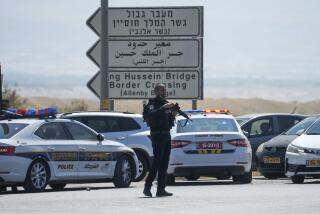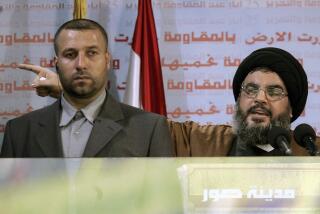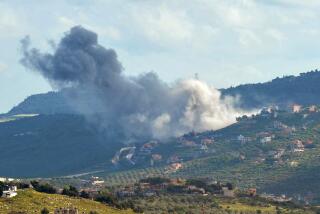Arab Gunman Kills 2 Israeli Soldiers; Link to Jordan Army Called Possibility
- Share via
JERUSALEM — An Arab gunman slipped across the Jordan River and ambushed an Israeli army patrol early Wednesday, killing two soldiers and wounding two before he was shot and killed, the Israeli military command announced.
It was the most serious incident on the border with Jordan in almost five years, and it may increase tension between Israel and Jordan at a time that the United States is trying to arrange peace talks between the two Mideast neighbors.
An Israeli army statement said the gunman carried papers “which give rise to the possibility that he was a soldier in the Jordanian army.” It said the attacker “crossed the river near an outpost of the Jordanian army.”
Identity Unclear
A military spokesman said it was not clear whether the man had help in infiltrating into Israeli-occupied territory and that it was not certain that the papers he carried were genuine.
The early morning attack came as Jordan’s King Hussein met in Amman for a fourth straight day with Yasser Arafat, chairman of the Palestine Liberation Organization. The two men are said to be seeking a common position on Washington’s effort to get discussions going on a comprehensive Mideast peace.
Israeli political and military leaders expressed skepticism that Jordan has changed its policy of trying to prevent cross-border attacks, although they emphasized that an investigation of the incident has not been completed.
“We will decide what to do when we know the details,” said Moshe Arens, an Israeli Cabinet minister without portfolio.
PLO Role Seen
Last summer, top government officials said that an increase in West Bank terrorism could be attributed in part to a growing PLO presence in Jordan. Former Defense Minister Ariel Sharon, now the industry and trade minister in the national unity government, said at the time that Israel should not rule out retaliatory strikes against PLO offices in Amman.
Yitzhak Shamir, who is foreign minister and alternate prime minister, described Wednesday’s attack as “another act of Arab terror against Israel.”
“I don’t think it will affect the peace process,” he said, however. “I don’t think it will have an impact on our relations with Jordan.”
Israel captured the West Bank of the Jordan River in the 1967 Middle East War and has occupied the area since. Infiltration was common in the first years after the war, but decreased sharply after Hussein expelled Palestinian guerrillas from Jordan in 1970.
The area where Wednesday’s ambush occurred, near the settlement of Mehola, was such a common infiltration route during the late 1960s that it became known to Israelis as the “Land of the Manhunts.” In recent years instances of infiltration from Jordan into Israeli-held territory have been rare.
1981 Incident Recalled
In 1981, a group crossed the river and managed to place land mines just south of where Wednesday’s ambush occurred. On that occasion an Israeli soldier was killed and eight others were wounded when an army vehicle hit one of the mines. They are believed to be the last army casualties connected with known infiltration from Jordan.
Army sources described Wednesday’s ambush as professional. They said it occurred in a mined area several hundred yards wide that lies between the Jordan and an electrified Israeli border fence east of Mehola.
They said the gunman apparently crossed the river at night and made his way to the dirt track used by the Israeli army to patrol the border. He hid behind a large boulder above a spot where the road dips sharply into a dry watercourse and fired on the Israeli patrol when it passed. He reportedly used an American-made M-16 rifle.
The army sources said one Israeli was killed instantly and the other died of his wounds before he could be moved to a hospital.
The gunman was killed by Israeli reinforcements who arrived on the scene in response to a call for help from the ambushed patrol, the sources said. They said the man appeared to be in his early 20s and was dressed in civilian clothes. He wore a red and white checked kaffiyeh, or headdress, of the sort worn by Jordanian soldiers but also by civilians in Jordan and on the West Bank.
More to Read
Sign up for Essential California
The most important California stories and recommendations in your inbox every morning.
You may occasionally receive promotional content from the Los Angeles Times.













